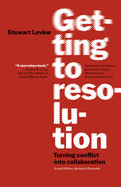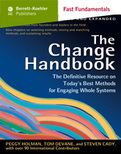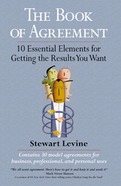

Stewart Levine
Alameda, California, USA
Community Member AuthorContact Stewart Levine
Stewart Levine
Stewart improves productivity while saving the enormous cost of conflict using “Agreements for Results” and “Resolutionary” conversational models. As a lawyer he realized fighting is ineffective in resolving problems. At AT&T he learned why collaborations fail: people do not create clarity about what they want to accomplish, and how they will get there. He has worked across the organizational spectrum – Fortune 500, small, government and non-profit. His “Cycle of Resolution” is included in the “Change Handbook, 2d Edition.” His book "Getting to Resolution: Turning Conflict into Collaboration” (Berrett-Koehler 1998, 2009) was an Executive Book Club Selection; Featured by Executive Book Summaries; named one of the 30 Best Business Books of1998; and called “a marvelous book” by Dr. Stephen Covey. It has been translated into Russian, Hebrew and Portuguese. “The Book of Agreement” (Berrett-Koehler 2003) has been endorsed by many thought leaders, called “more practical” than the classic “Getting to Yes” and named one of the best books of 2003 by CEO Refresher (www.Refresher.com). Along with David Coleman he wrote “Collaborate 2.0” that was released in February 2008. He teaches communication, relationship management and conflict management skills for The American Management Association, the University of California Berkeley Law School and Dominican University Graduate Business School. www.ResolutionWorks.com
Most approaches to conflict resolution and negotiation result in just temporary settlement, compromise, or capitulation. ...
from BK Fast Fundamentals
Crafting agreements with others is a fundamental life skill. Unfortunately, we were never taught how to do it. The agreem...
Programs for Law Firms
Programs for Partnerships
Programs for Couples
Programs for Individuals
eLearning: Online Courses
Stewart has worked for American Express; Chevron; ConAgra; DC Government; EDS; General Motors; Honda; Kaiser; NASA; Oracle; Safeco; University of San Francisco; U.S.Depts. of Agriculture and the Navy.
Contact Stewart for his fee structure.
We certainly enjoyed your positive presentation of a topic most folks find very difficult to discuss – “conflict”. Your message of open communication and recognizing how past experiences play a part in our individual attitudes toward resolving conflict really hit home to me. >From the comments I received during break and after lunch, I believe you delivered timely message to the rest of my staff as well. Your uplifting closing remarks set the tone for a productive and effective afternoon training session for everyone. Thank you ever so much.
–
Barbara Cassens, Director, San Francisco District FDA, Pacific Region
You were able to lead a roomful of legal know-it-alls to a foolproof technique for avoiding the unnecessary communication problems that get in the way of achieving mutually satisfying resolutions of conflict. In just a few hours, you showed us how to reacquire the lost art of LISTENING. I am getting along better at the office, at home, and at the courthouse.
–
F. Ford Loker, Esq., Maryland State DRI Representative
You resolve issues that stifle productivity and create partnership where everyone thought it was impossible. Gail Johnson, Sierra Adoption Services I am using your model in many business situations for teaming, managing client relationships and negotiating large sales and contracts.
–
TG Struttman, Caterpillar Inc, OC
Stewart Levine has developed a model for conflict resolution that could revolutionize the manner in which we speak, communicate, and settle our disagreements. Mr. Levine is an attorney who has witnessed first hand the litigious system. He is suggesting that for the majority of issues that confront us in our daily lives there is an alternative, a less costly, and a more efficient methodology in which to achieve our goals. As someone who has spent the better part of the past twenty years attempting to assist people in settling conflicts, I can attest to the value of Mr. Levine’s methodology.
–
Dan Corsello, Dir., Napa County Health & Human Services
It’s always a treat to watch, listen, and learn from a master. . . . There’s a definite buzz for More! from our participants.
–
Univ. of San Francisco, Office of Personnel Services
In the workforce I found that the agreement model transcends all lines of management and can be incorporated in relationships with direct reports, colleagues, and senior management. I have seen my direct reports become empowered as they are enabled to have individual input and share in the credit of the results; my management benefits because the entire team is in agreement and harmony as to how to achieve the end results. Now, when original agreements are broken or simply cannot be met, we have learned to use this tool to implement new or revised agreements. This has allowed what could have been negative situations to become positive and productive experiences.
–
Jan Gould, Dir., Membership, VISA
Getting to Resolution is an important book for the hectic time we live in. It is a reminder that civilization rests on our ability to communicate with each other, and resolve differences in a peaceful way. This is true for individuals, organizations, and nations. We cannot afford to file lawsuits or start wars when good communication will get us to the other side of our differences.
–
Lord Graham of Edmonton, Opposition Chief Whip, House of Lords, London






